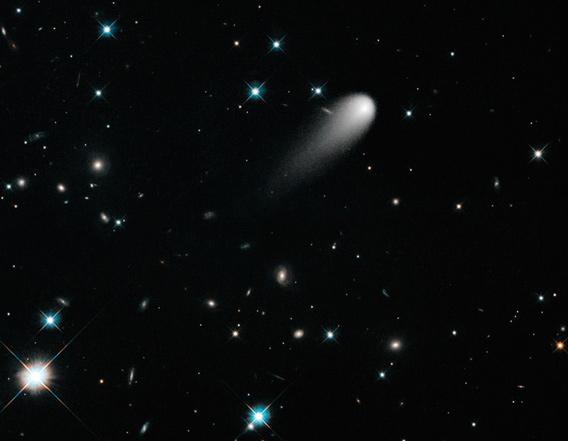In late November of this year, a chunk of ice and rock called comet C/2012 S1 (ISON)—colloquially just comet ISON—will plunge deep into our inner solar system, skimming the Sun’s surface just 1.2 million kilometers (700,000 miles) above the star. At that time, it may get bright enough to see with the naked eye, an event eagerly awaited by astronomers (like me)—I’ve written up all the details in earlier posts.
In the meantime, though, there’s a lot we can learn about ISON. In April, the Hubble Space Telescope was pointed at the iceball and took this spectacular image of it among the stars:

Photo by NASA/ESA
This false-color picture is actually a composite of several images taken in two filters: One lets through red light (shown as red in the picture) and the other yellow-green light (shown in blue). The comet was about 600 million kilometers (360 million miles) from Earth when this picture was taken and traveling rapidly enough that it moved visibly between exposures. The composite image was made by keeping the stars steady between exposures, and then cutting out the moving comet in each image and aligning them for the final result.
Images like this are more than just eye candy; the observations help nail down the orbit of the comet to high accuracy and look for cometary activity as well. Even though it’s far from the Sun, ISON has been pretty active, with a healthy tail. That forms when ice in the comet nucleus sublimates (turns from a solid to a gas) due to sunlight, and it’s a bit unusual to see this much of a tail from a comet so far out.
Comets are notoriously hard to predict when it comes to brightness, and there’s hope this will be a very bright one around the winter holidays. But it’s hard to say; we’ll know better, of course, as time goes on.
If you want to keep up with news about the comet, the folks at Hubble have started a Comet ISON blog, where they’ll post info and pictures. They’re also hosting a live Google Plus Hangout at 20:00 UTC (4 p.m. EDT) today (Wednesday, July 17), where they’ll answer your questions on air.
As time goes on I’ll be keeping up with the comet as well, especially since I plan to do a lot of observing of it in the frigid winter air of Colorado. If this comet is even a fraction as bright as hoped, it’ll still be worth taking a look at. And if it does perform, well, you definitely won’t want to miss that.